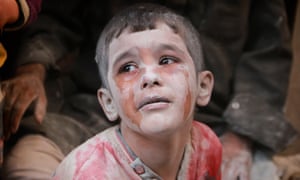As Aleppo burns in this age of lies, Picasso's Guernica still screams the truth about war - Jonathan Jones
The flames of Guernica still burn in modern
memory. In 1937, the Nazi German air force bombed this ancient city in the
hills of Spain’s Basque region on behalf of the fascist side in the Spanish
civil war. The attack took more than 1,600 lives and was a revelation of the
horror of bombing raids on civilians, which would soon become the norm when
world war broke out two years later.
See images of Picasso's famous painting
This week former
minister Andrew
Mitchell called up Guernica’s ghosts. “What Russia is doing to the
United Nations is precisely what Italy and Germany did to the League of Nations
in the 1930s,” he
said in the House of Commons. “And they are doing to Aleppo precisely
what the Nazis did to Guernica in the Spanish civil war.”
The power of Guernica
– to make us see the crimes of our own time more clearly – is a tribute to the
moral efficacy of art. There is a reason everyone recognises Guernica as an
image of the barbarity of bombing. The second world war saw far more murderous
air attacks, yet Guernica is the most universally remembered example of the
pity of air raids – because Picasso painted it.

A wounded Syrian child cries in Aleppo, Syria on October 11, 2016.
Photograph: Anadolu Agency/Getty Images
Mitchell referred to
the bombing of the Basque capital as a comparison to wake us up. Portuguese
cartoonist Vasco Gargalo, meanwhile, has returned to Picasso’s painting itself. His viral picture Aleppo inserts
the faces of Vladimir Putin and Bashar al-Assad into Picasso’s nightmare and
turns an impaled horse into an allegory of the United States.
Why can Guernica help
us to see the truth about Syria?
Picasso painted his masterpiece quickly on a huge panel in his studio in a loft
on the Left Bank in Paris. He showed it at the Spanish pavilion in the 1937
Paris universal exhibition. It did not stop the horrors of the Spanish civil
war nor save Spain from 36 years of fascist rule. Yet looked at today it is
prophetic; every bomb dropped on a human being makes its profundity all the
more apparent.
Guernica is not a
conventional history painting nor a factual recording of what happened, but a
cubist apocalypse painted by the most revolutionary of modern artists. The
human body is no match for the technology of bombing, and Picasso shows us
exactly what that means. A warrior’s remains lie broken and scattered. The dead
face of a baby is delineated in a few simple heartbreaking marks. Someone is
trapped in a burning building.
Through the
fragmenting lens of cubism he is able to make us see a battering tumult of
horrors in the same instant. He forces us to respond to them as real, tangible,
physical moments of incredible violence and pain. By abstracting from reality,
Guernica concentrates the mind on the essence of atrocity: the dead baby’s
face, the figure in the fire. It can make us see extremes of injury and death
that most photographs rightly shun, because Picasso paints the human suffering
within, rather than gazing on cruel details.
In 1937 the courage of
this painting was to tell the truth in an age of lies. That is still what it
does. The most awful analogy between today and the 1930s is that truth is being
crushed by lies and propaganda – we are in a post-truth age. Politicians such
as Putin and Donald Trump say whatever they like. The internet muddies every fact
with a counterfact and there are so many conspiracy theories that no one
believes anything. Yet we have been here
before. In the 1930s, totalitarian propaganda machines attacked the very idea
of truth. Hitler and Stalin waged permanent war on facts using radio, cinema,
censorship and brainwashing mass rallies.
Picasso knew exactly
what he was doing when he painted Guernica. He was trying to show the truth so
viscerally and permanently that it could outstare the daily lies of the age of
dictators. Nazi Germany and Stalinist Russia had huge pavilions at the
1937 exhibition where Guernica was unveiled, but Picasso – just one
man bearing witness to the truth – painted the human reality of that vile time.
It has outlasted all propaganda.
We need to fight for
the truth as bravely as Picasso did. It is not only bombs that are killing
people in Aleppo,
but Putin’s lie machine as well.
